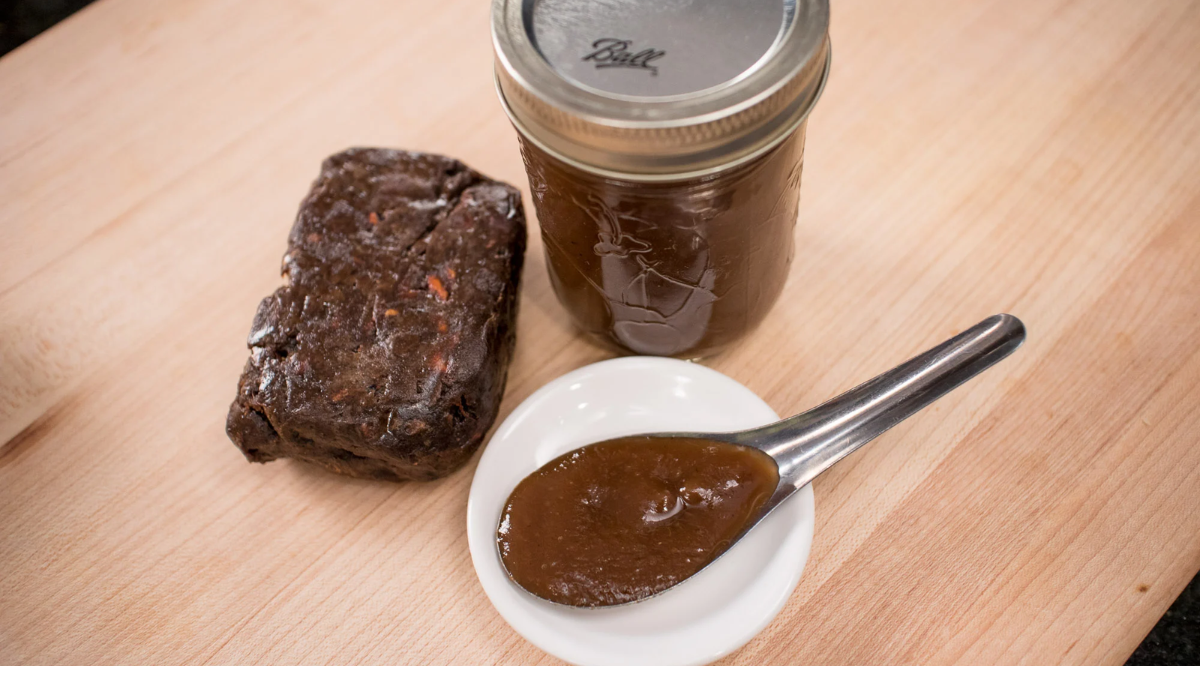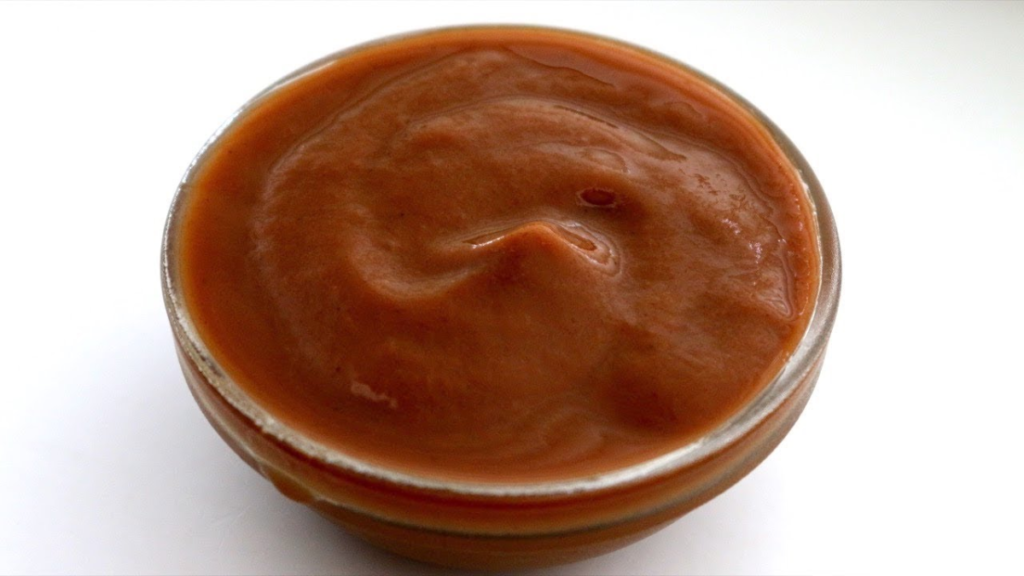The ingredient tamarind paste is used frequently in South Indian cuisine. It is one of the primary souring ingredients found in numerous recipes. Tamarind paste can be easily prepared at home and has a long shelf life. It’s worth the effort and use in regular cooking. Typically, tamarind blocks purchased from stores include the seed as well. Before creating the pulp, we must remove the seeds and the tough fiber. Since it’s simpler to store the seeds after cooking, I like to remove them before cooking.
What is Tamarind Paste?
The tamarind tree is a common hardwood fruit tree with African roots throughout Asia and Mexico. It produces enormous brown pods that are filled with tamarind fruit. The pulp envelops the seeds inside the tamarind pod, found in the tamarind tree’s fruit or pods used to make tamarind paste.
To create a ready-to-use cooking paste, the dark reddish-brown fruit from the pods must first be separated from the seeds. It is inexpensive and keeps for a very long time, whether you create or purchase it already. Fun fact: The tamarind tree is a member of the Fabaceae family and is a leguminous plant. Technically, its fruits are legumes.
How to Make Tamarind Paste?
Pure tamarind paste can be made using just one primary ingredient and a little water. Finally, there are modifications where some people include salt or sugar. This is because Tamarind pulp is frequently preserved with salt to help it stay fresher longer in the form of a ball. However, since we will be heating the tamarind paste to kill bacteria, if you produce Tamarind paste from scratch, you won’t need to add salt or sugar to preserve the tamarind pulp. You can instead store a plain-tasting Tamarind paste.
This paste can be used in sauces, foods, and beverages and stays well in the refrigerator. You can use the paste in various ways because it isn’t salted or sweetened. Preservatives are always added to the tamarind paste sold in jars and pressed into a very thick paste after being reduced. Even while those pastes tend to disintegrate more slowly, you can control the consistency when you manufacture your own.
It is simple to utilize tamarind paste straight from the container. Whatever recipe you are cooking will require sugar or another form of sweetness due to its sour taste; tamarind imparts foods with an exquisite yet delicate, sweet-sour flavor when mixed with sugar. Depending on your type, tamarind paste might vary greatly in thickness and spiciness. To get the proper flavor, you must add additional if the paste is runny. To obtain the ideal sweet-sour balance, taste-test your recipe. If necessary, add more paste or sweetener to create the desired flavor. The tamarind tree’s edible fruit is used to make tamarind paste.
Like lemon juice, tamarind paste has a mild acidity but not as much as apple cider vinegar. The flavor of the fruit is sweet and sour, and the flavor profile of the paste is quite similar to that of fresh tamarind, albeit more potent. Tamarind pods are cooked in boiling water for about an hour to form tamarind paste. The liquid is then strained through a fine mesh strainer to remove the pulp, which thickens as it absorbs the hot water. Avoid forcing the tamarind through the sieve while producing tamarind paste at home to prevent the inclusion of mud and stones in the finished paste.
Ingredients
- 1.2 pounds of seedless tamarind pulp (see note)
- two hot cups of water
Preparation
- The tamarind block can be broken into manageable pieces with your hands and put in a sizable, heat-resistant mixing bowl. The longer the tamarind sits, the simpler the next step will be. Pour the boiling water over the tamarind and let it sit for about 20 minutes, or until it is cold enough for you to handle. 2 cups of boiling water, 12 kg of seedless tamarind pulp (see remark).
- To separate the pulp from the fibers, scrunch and squeeze it with your hand, preferably while wearing gloves, to prevent tamarind from becoming trapped in your nails. The final product ought to resemble a smoothie in consistency.
- Avoid using a fine-mesh screen or colander when straining the tamarind mixture into a pot because the paste will be thick. Try to get as much liquid through the sieve as possible and sometimes scrape the bottom. Do this once you feel most of the pulp has been separated from the fibers.
- Pour 12 cups of room temperature water over the remaining fibers in the sieve, stirring it with your hand as you go. This will remove any remaining tamarind that may be lodged in the fibers.
- You can use this right away for cooking. However, for storage, simmer the tamarind paste over medium-high heat until it boils, constantly stirring because it is fairly thick and can bubble and jump at you if you don’t stir. Before turning off the heat, let it bubble for 4-5 minutes to ensure it is completely heated.
- Transfer the hot tamarind paste to clean miniature mason jars with a maximum capacity of 1 cup. I like to use smaller ones to reduce the time each jar is open. Before putting them in the refrigerator for storage, close the lids while they are still hot and let them cool at room temperature. Since this was not properly canned, you still need to keep it in the refrigerator. As it cools, the lids will be drawn in, and the food will seal very effectively, much like jam. They can also be placed on ice cube trays to freeze, and the cubes can be kept in freezer bags.
Is there a Substitute for Tamarind Paste?
There is nothing that can match the flavor and consistency of tamarind. Therefore the answer would be no. However, in some recipes, lime juice can be used in place of tamarind paste. Depending on the recipe is a given. A Worcestershire sauce, for instance, would not taste the same if lime juice were substituted for tamarind paste. Tamarind is also used to flavor drinks.
In Mexico, for instance, tamarindo is used, and if lime juice is substituted, the result will not be the same. Therefore, you might substitute rice vinegar or lime juice for tamarind paste in several sauces, curries, and marinades. Making tamarind paste will be very helpful if you intend to cook more tamarind-based recipes, including roasted chicken with tamarind glaze.
What Happens if we Eat Tamarind Daily?
Tamarind benefits your health, protecting your liver and heart from illness and increasing your immune. Tamarinds are fat-free and high in fiber. Tamarind includes flavonoids and polyphenols. Thus it may potentially help with weight loss, according to studies. Magnesium is abundant in tamarind. Additionally, compared to many plant foods, it has greater calcium.
These two minerals combined with weight-bearing exercise may help ward off osteoporosis and bone fractures. Calcium utilization in the body requires vitamins D.Many people who are sensitive to the components of this fruit end up experiencing a variety of symptoms after consuming it, including rashes, itching, inflammation, stinging, lightheadedness, fainting, vomiting, shortness of breath, etc.
Uses for Tamarind Paste
Tamarind paste is a tasty complement to various cuisines because of its sweet, tart, fruity, and acidic flavor. The following five uses for tamarind paste are:
Candy: Tamarind paste is particularly used in Mexican candy. The chewy, sweet sweets bring out the tamarind flavor. The candies come in various shapes, including hard candy and tamarind rope.
In Indian and Middle Eastern cuisines, tamarind chutney is a common condiment. Thick, sweet, tangy, and typically flavored with mango—either through mango powder, also known as amchur powder or amchoor, or otherwise—tamarind chutney has all these characteristics.
Pad thai: To make the traditional pad thai dish, combine the tamarind paste with the following ingredients: fish sauce, brown sugar, lime juice, tofu, chicken, peanuts, and bean sprouts. One of the most often used substances in Thailand is tamarind paste.
Stir-fry: Tamarind paste is added to stir-fry, a traditional Chinese meal, to give it a distinct Thai flavor. Add ginger, scallions, and citrus juice to the dish to counteract the tamarind flavor.
Tamarind balls: Tamarind balls are a traditional treat in the Caribbean. Cooks roll the fruit in sugar in Jamaica and Trinidad; in other areas, the paste is formed into balls and then rolled in sugar.
Storage Tip
Most tamarind paste jars and containers advise storage in a cold, dry environment, so your spice cabinet will work fine. However, you’ll see that tamarind users frequently suggest refrigerating to preserve freshness and lengthen shelf life. Before using, you might need to stir or thin the contents out with water because it tends to thicken. If it is correctly sealed, it will last for several months.
Tamarind Paste vs. Concentrate
Tamarind paste and tamarind concentrate are interchangeable terms in most supermarkets. When a recipe asks for tamarind concentrate, tamarind paste can typically be substituted without any problems. Some people, however, clearly distinguish between tamarind paste and tamarind concentrate, with the taste being the primary differential.
Since tamarind paste is made from fruit, its flavor is more potent than tamarind concentrate. Some concentrations are made from the fruit’s other portions or juice, which has a bland flavor. Indian tamarind concentrate is a common source. All of this could change based on the brand’s quality. Be aware that some tamarind pastes and concentrates sold in grocery stores contain artificial sweeteners or preservatives.
Where to Buy Tamarind Paste?
Jars or plastic containers are used to sell tamarind paste. One jar of paste will keep for a very long period because it is robust and concentrated. Some Asian grocery stores have tamarind paste, but you might have better luck finding it in Indian grocers. Additionally, buying it online is not too difficult. It’s simple to make your own if you want to. Finding dried pods at Asian markets and even certain supermarkets is simple. Remove the fruit by cracking them open. For 10 to 15 minutes, simmer them in a pot with about 1/4 cup of water.
The fruit should be gently mashed against the pan’s bottom and sides after the pan have been taken off the heat. Remove the dark liquid by straining it out, then press the fruit through a fine-mesh screen to get the most pulp while removing the seeds. You can now use your tamarind paste. Although one might object to using something else instead of tamarind paste, there are instances when an ingredient is hard to come by or when the need to prepare a dish with it hits when a grocery shop is closed.
There are two frequent alternatives to tamarind paste: one is a vinegar and sugar solution, and the other is freshly squeezed lime juice. If the recipe you want to make calls for tamarind as the primary ingredient, like in a recipe for Thai tamarind fish, neither alternative works well. Dishes like pad thai chicken benefit from the vinegar-sugar combination. Replace the one tablespoon of tamarind paste in your recipe with one tablespoon of vinegar and one brown sugar. For every tablespoon of tamarind paste, use two tablespoons of fresh lime juice instead. Two teaspoons or less of tamarind paste is ideal when using one of the two alternatives.
Conclusion
A tamarind tree produces a bitter, black, sticky fruit used to make tamarind paste. Tamarind paste is primarily used in savory dishes in Thai cooking, unlike in other cultures where it is utilized to make desserts and even candies. Tamarind is a key ingredient in many Thai curries and seafood meals, including the traditional pad thai sauce. Tamarind is frequently used in Indian curries. Additionally, it is frequently used in Vietnamese, Latin, and Caribbean cuisine and Indian and Mexican dishes. In Worcestershire sauce, it is a vital component that gives the sauce its unique tang. This is the procedure.

